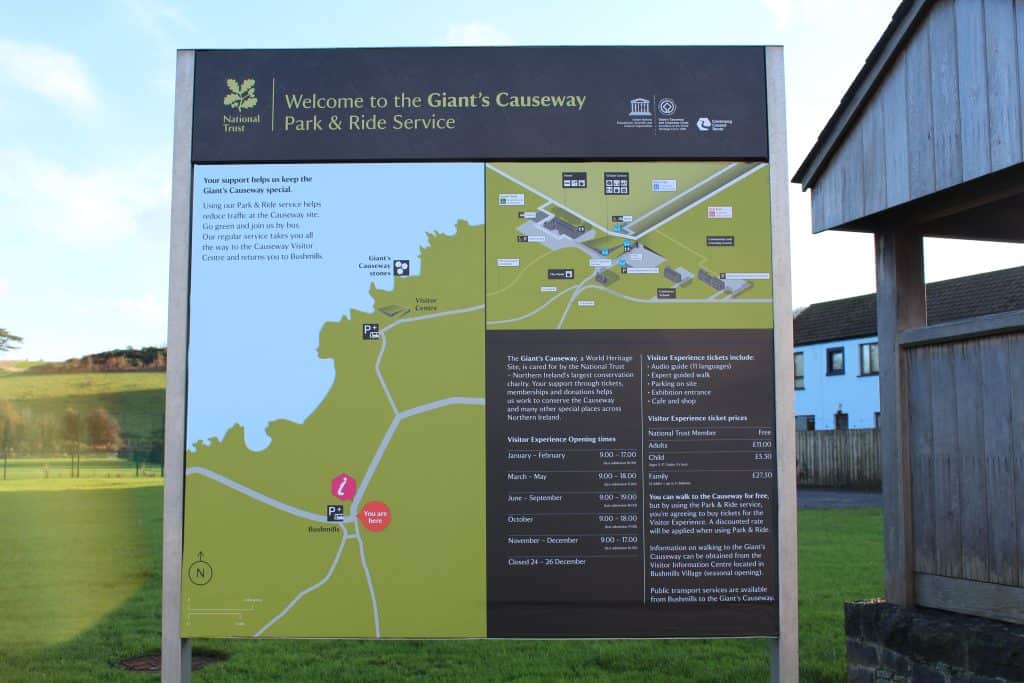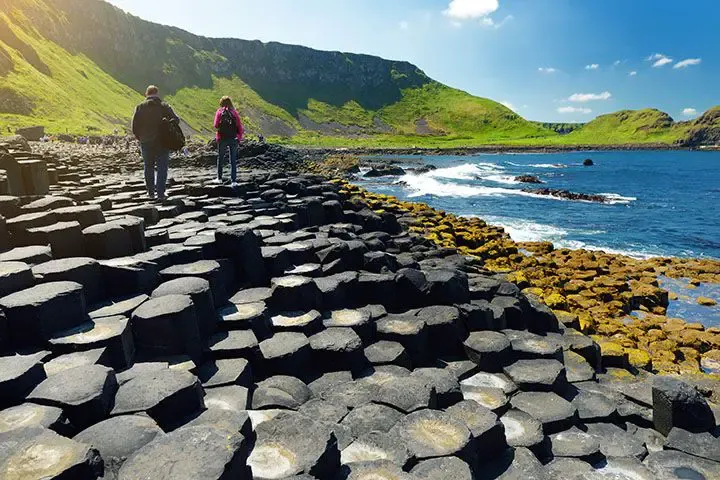The Guide to Have The Best Giants Causeway Visitor Experience
Welcome to one of the most amazing places on the planet: The Giant’s Causeway. The Giants Causeway comprises around 40,000 thousand primarily hexagonal basalt columns descending gently into the sea. Depending on who you believe, the stones were formed either by an underwater volcano’s geological actions or by a giant named Finn McCool, who lived and battled along the north Antrim Coast. The causeway coastal route is a scenic drive along the Antrim Coast, featuring the Giant’s Causeway and a series of stunning natural and cultural attractions.
Giant’s Causeway Official Guide prides itself on offering a place to find fun and educational guided tours for you, your family, and your friends. We delight in sharing this natural wonder with visitors to Northern Ireland, where the Giant’s Causeway stands as a UNESCO World Heritage site and one of the most popular tourist attractions in the country.
Make your trip memorable by spending a day on a tour of The Giant’s Causeway from Portrush, Belfast or even Dublin. You will comprehensively visit Northern Ireland’s only UNESCO World Heritage site and nearby famous attractions along the north coast. Notable stops along the causeway coastal route include Dunluce Castle, perched dramatically on the cliffs, and Whiterocks Beach, known for its pale cream sands and scenic beauty. There’s no need to read about the rich history; let our tour guide provide the facts and figures while you focus on taking in its beauty.
Travel along the iconic Giant’s Route in comfort, and let yourself be enchanted by the gorgeous locations on the Antrim Coast, the lush beauty of the Irish landscape, and the Giant’s Causeway itself—one of the most popular tourist attractions in the area. Take away the hassle of checking maps and stopping to ask for directions, and we will ensure you see the best spots and get plenty of time to explore the Giant’s Causeway.
Check out our Tours Page for a range of excellent tours.
About The Giant’s Causeway
The coastline of County Antrim in Northern Ireland is renowned for its scenic beauty, possibly the world’s best driving route, the Causeway Coast Route, clinging to its edge. Sitting at the northern end, the Giant’s Causeway takes centrepiece as the crown’s unique jewel, known as the 8th Wonder of the World to many here in Ireland and beyond. The famous jagged promontory of around 40,000 neatly packed columns of hexagonal volcanic basalt columns, which are among the most remarkable natural features of the region, were created some 6 million years ago by a basaltic lava flow.
The Giant’s Causeway is a place where myth and science meet. Were the spectacular basalt columns formed through the rapid cooling of lava from an underwater volcano, or, as some may say, created by the legendary mythical Irish Giant Finn MacCool? The site’s iconic columns are the result of ancient volcanic activity, where intense eruptions and subsequent cooling created the unique geological formations seen today.
For centuries, countless visitors have explored the Giant’s Causeway stones and marvelled at its unique rock formations. Situated on one of the world’s most spectacular coastlines, its unique rock formations have stood as a natural rampart for nearly sixty million years against the unbridled ferocity of the North Atlantic storms. Changes in sea level over time, along with powerful storm events, have continually shaped the coastline and the basalt columns, influencing both their appearance and accessibility. The rugged symmetry of the columns never fails to intrigue and inspire our visitors. To stroll on the Giant’s Causeway is to voyage back in time.
The iconic basalt columns, often likened to stepping stones leading into the sea, invite exploration and wonder. Coastal paths wind through the area, allowing visitors to experience the natural beauty, geology, and legends of the Giant’s Causeway up close.
The Giant’s Causeway Visitor Centre

In 2012, the new architecturally designed bespoke Giant’s Causeway Visitor Centre opened, replacing the original building built in 1986 when UNESCO added the Giant’s Causeway to its coveted list of exceptional interest and universal site value.
The new Giant’s Causeway visitor centre is the gateway to the famous Giant’s Causeway, semi-hidden in the hillside. It offers various ways to learn about myths, legends, social history, wildlife and conservation. There are large screens for shows, a shop (selling souvenirs and local crafts), and a cafe that supplies books, pamphlets, tourist information and multi-lingual audio guides. These facilities are aimed at improving everyone’s experience at the site.
The National Trust runs the Causeway Visitor Centre, so it’s free to enter with a National Trust Membership. Visitor experience ticket holders and National Trust members can use their membership number when booking tickets or parking online. Visitors can use the justpark app to pre-book parking at the site, including at Innisfree Farm. The use of digital services, such as apps available on Google Play, helps streamline ticketing and parking. Timed entry and pre-booking help to spread visitor numbers throughout the day for a better experience.
Find out more and see opening times here.
Getting To The Giants Causeway

The Giant’s Causeway lies about an hour’s drive northwest of Belfast and three hours north of Dublin. We recommend you take the fabled Causeway Coast Route drive to get here. The closest towns are Bushmills, with its world-famous distillery, the holiday destination of Portrush and the County Town of Coleraine. You can get to the Causeway by Rail, Bus or Coach, each having an excellent scenic route.
You can visit the stones once you arrive at the car park and have been through the visitor centre. In addition to the main car park, Innisfree Farm offers alternative parking with a shuttle service to the site. Visitors can use the justpark app to pre-book parking at both the Giant’s Causeway and Innisfree Farm. For added convenience, travel and parking apps such as justpark can be downloaded from Google Play. National Trust members can enter their membership number when booking parking online to receive free or discounted access. Visitor experience ticket holders should have their tickets ready for entry and parking. Pre-booking and timed entry help to spread visitor numbers and avoid overcrowding. You can get the bus run by the National Trust or walk.
The walk is about half a mile or a kilometre from the Visitor Centre along the coast, heading eastward, and the area is well marked with signs and information plaques.
The walk is reasonably straightforward, with a consistent slope down to the causeway level on a tarmac path, with plenty of places to stop. The walk takes you around the first headland, where you’ll get your first glimpse of the Giant’s Causeway in the distance. You can also take in the stunning landscape, cliffs, and an array of ancient volcanic artefacts.
History of the Giant’s Causeway
Despite the Giant’s Causeway being formed over 60 million years ago, the 40000 or so basalt columns of the Giants Causeway only came to be known by the broader public from around 1690 when it was “discovered” by the Bishop of Down and Conor, William King. Here, you can discover more about the Giants Causeway’s history and how it became a world heritage site.
Myths & Legends of the Causeway
The Giant’s Causeway, near Bushmills, has been drawing thousands of tourists from near and far with its mystery and rare geological formations; however, according to legend, the columns are the remains of a causeway built by a giant Finn McCool. The story goes that the Irish giant Fionn mac Cumhaill (Finn MacCool), from the Fenian Cycle of Gaelic mythology, was challenged by the Scottish giant Benandonner. Fionn accepted the challenge and built the causeway across the North Channel to reach Scotland and confront Benandonner. The legend describes how the giant constructed these iconic stepping stones as a path to Scotland, connecting the two lands both mythologically and geographically. The legend of Causeway Giant’s Finn McCool and Benandonner battle is told on the big screen in the Giant’s Causeway Visitor Centre, which the National Trust runs.
Find out more here about Fionn McCool
Geology Of The Giants Causeway
“When the world was moulded and fashioned out of formless chaos, this must have been the bit over—a remnant of chaos!” William Thackeray Tweet Thackeray’s
The Giant’s Causeway has some of the most amazing geological experiences on the Causeway Coast and Northern Ireland. The unique basalt columns and surrounding formations are the result of ancient volcanic activity, when eruptions of basaltic lava during the Paleocene epoch cooled and fractured to create the iconic landscape. Visitors of this popular tourist spot have more than just the stones to view, with many natural phenomena such as the Giant’s Boot, the wishing chair, and the Giant’s Organ.
The coastal walk to the stones takes in many of these, offering the opportunity to get the obligatory selfie on the giant’s boot.
Walks at the Giant’s Causeway

The Giant’s Causeway has several fun walks, allowing you to spend hours soaking up these ancient volcanic surroundings’ mystery, mythology, and geology.
Our favourite is the Red Trail, a 2-mile walk east from the Visitors Centre along the cliff’s top and then descending a (fairly steep) staircase carved into the cliffs, bringing you out beyond the Giant’s Causeway to the coastal path and the Blue path. You experience a fantastic bird’s eye view of the coast from here, and it is a breathtaking experience and worth the effort for the giant view alone!
Blue Trail: The Blue Trail is the main walking path from the National Trust visitor centre, past the cliffs and the Giant’s Causeway.
Yellow Trail: The Yellow Trail follows the World Heritage Site’s perimeter, starting at Runkerry Head and ending at Hamilton’s Seat. The Yellow Trail joins the Green and Red Trails in parts.
Green Trail: This trail is perfect for walking the kids along; it’s wheelchair and buggy-friendly. It’s also fenced off from the clifftops, so little ones can roam free in plain view along this path.
If you’re looking for a shorter, guided experience, try the wee walk—a short, guided coastal hike that offers scenic views of the area’s natural features. Along the wee walk, guides share stories about the local geology, legends, and folklore, making it an accessible and memorable way to explore the Giant’s Causeway.
Insert Walking Tours here.
Similar Structures Around The World
The Giant’s Causeway is not as unique as you’d think. Similar sites worldwide are home to impressive hexagonal columns like those found on the North Antrim Coast. The nearest is just across the water on a Scottish Island Called Staffa Flow, where Fingals Cave is lined with large basalt columns. You can see similar structures in Isreal, Iceland, Mexico and Russia….but obviously, none are as fantastic as The Giant’s Causeway.
A Gallery of The Causeway
The Giant’s Causeway is one of Northern Ireland’s, if not the world’s, most photographed places. With stunning sunrises and sunsets and incredible images of the solar system. Check out some of the fantastic pictures we’ve found on our Instagram.
Flora & Fauna
The Giant’s Causeway isn’t just home to incredible rock formations. The Giants Causeway and the Causeway Coast are a haven for sea birds such as fulmar, petrel, cormorant, shag, redshank guillemot and razorbill. Simultaneously, the weathered rock formations host several rare and unusual plants, including sea spleenwort, hare’s foot trefoil, vernal squill, sea fescue and frog orchid.
Accessibility at the Giant’s Causeway
The Giant’s Causeway, a UNESCO World Heritage Site on the stunning Causeway Coast of Northern Ireland, is dedicated to making this world-famous destination accessible to all. Nestled in County Antrim near the charming Bushmills village, the site welcomes visitors of every ability to explore its legendary basalt columns and dramatic Atlantic Ocean views.
The Giant’s Causeway Visitor Centre is designed with accessibility in mind. Wheelchair users and those with mobility needs will find ramps, lifts, and accessible facilities throughout the centre, including the café, shop, and interactive exhibitions. Audio guides are available to enhance your visit, and guided tours can be tailored to suit different requirements, ensuring everyone can enjoy the stories of the Irish giant Fionn mac Cumhaill (Finn McCool) and the Scottish giant Benandonner.
Getting close to the ancient volcanic eruption site is made easy with a paved path leading from the main car park at the Visitor Centre down to the famous rock formations. For those who prefer not to walk, the Causeway Rambler service and the Antrim Coaster service offer regular, accessible transport between the Visitor Centre and the stones, making the journey comfortable and convenient.
To make the most of your visit, it is strongly recommended to book Visitor Experience tickets online in advance. These tickets include access to the Visitor Centre, guided tours, and audio guides, ensuring a seamless experience. National Trust members enjoy free admission, but pre-booking is still advised to guarantee entry, especially during peak times. For added convenience and savings, the Bushmills Visitor Information Centre offers a Green Ticket, which bundles parking, bus fare, and Visitor Experience admission—ideal for those arriving by car or using the regular bus services.
Travel to the Giant’s Causeway is straightforward, with options including the Ulsterbus Service, Goldliner Service, and mini coaches connecting the site to nearby towns and cities. Ample parking is available at the main car park and the Dundarave Car Park in Bushmills, with designated spaces for visitors with disabilities.
By spreading visitor numbers throughout the day and offering a range of accessible services, the National Trust ensures that everyone can experience the outstanding universal value of this world heritage site. Whether you’re captivated by the myths of giants or the awe-inspiring geological features formed over 60 million years ago, the Giant’s Causeway promises an unforgettable adventure for all who visit.

